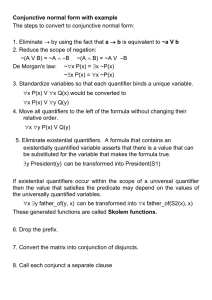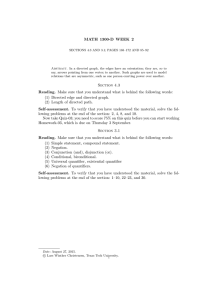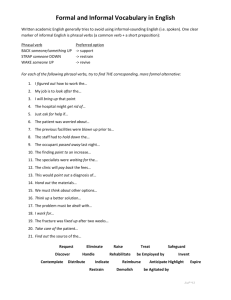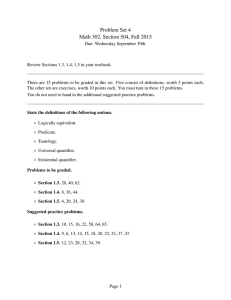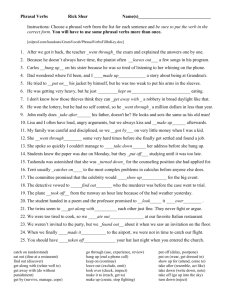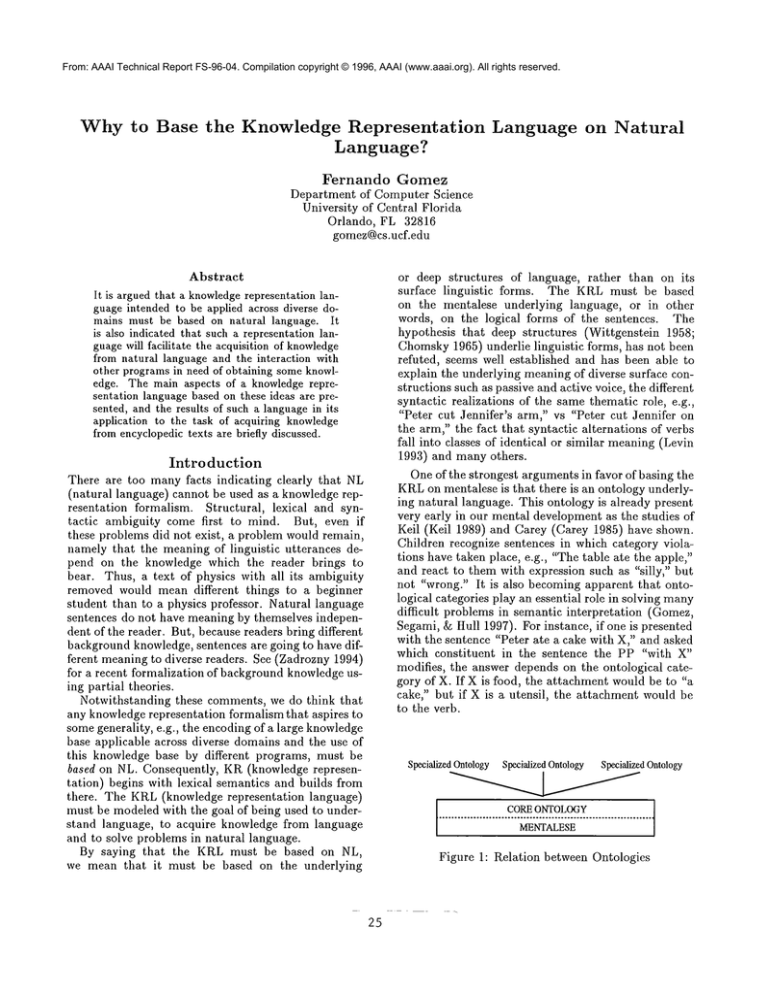
From: AAAI Technical Report FS-96-04. Compilation copyright © 1996, AAAI (www.aaai.org). All rights reserved.
Why to Base the
Knowledge Representation
Language?
Language on Natural
Fernando
Gomez
Department of Computer Science
University of Central Florida
Orlando, FL 32816
gomez@cs.ucf.edu
Abstract
It is argued that a knowledgerepresentation language intended to be applied across diverse domains must be based on natural language. It
is also indicated that such a representation languagewill facilitate the acquisition of knowledge
from natural language and the interaction with
other programsin need of obtaining someknowledge. The main aspects of a knowledgerepresentation language based on these ideas are presented, and the results of such a languagein its
application to the task of acquiring knowledge
from encyclopedictexts are briefly discussed.
Introduction
There are too many facts indicating clearly that NL
(natural language) cannot be used as a knowledgerepresentation formalism. Structural, lexical and syntactic ambiguity come first to mind. But, even if
these problems did not exist, a problem would remain,
namely that the meaning of linguistic utterances depend on the knowledge which the reader brings to
bear. Thus, a text of physics with all its ambiguity
removed would mean different things to a beginner
student than to a physics professor. Natural language
sentences do not have meaning by themselves independent of the reader. But, because readers bring different
background knowledge, sentences are going to have different meaning to diverse readers. See (Zadrozny 1994)
for a recent formalization of background knowledgeusing partial theories.
Notwithstanding these comments, we do think that
any knowledgerepresentation formalism that aspires to
somegenerality, e.g., the encoding of a large knowledge
base applicable across diverse domains and the use of
this knowledge base by different programs, must be
based on NL. Consequently, KR(knowledge representation) begins with lexical semantics and builds from
there. The KRL(knowledge representation language)
must be modeled with the goal of being used to understand language, to acquire knowledge from language
and to solve problems in natural language.
By saying that the K1EL must be based on NL,
we mean that it must be based on the underlying
25
or deep structures of language, rather than on its
surface linguistic
forms. The KR.L must be based
on the mentalese underlying language, or in other
words, on the logical forms of the sentences. The
hypothesis that deep structures (Wittgenstein 1958;
Chomsky1965) underlie linguistic forms, has not been
refuted, seems well established and has been able to
explain the underlying meaning of diverse surface constructions such as passive and active voice, the different
syntactic realizations of the same thematic role, e.g.,
"Peter cut Jennifer’s arm," vs "Peter cut Jennifer on
the arm," the fact that syntactic alternations of verbs
fall into classes of identical or similar meaning(Levin
1993) and many others.
One of the strongest arguments in favor of basing the
KRLon mentalese is that there is an ontology underlying natural language. This ontology is already present
very early in our mental development as the studies of
Keil (Keil 1989) and Carey (Carey 1985) have shown.
Children recognize sentences in which category violations have taken place, e.g., "The table ate the apple,"
and react to them with expression such as "silly," but
not "wrong." It is also becoming apparent that ontological categories play an essential role in solving many
difficult problems in semantic interpretation (Gomez,
Segami, &Hull 1997). For instance, if one is presented
with the sentence "Peter ate a cake with X," and asked
which constituent in the sentence the PP "with X"
modifies, the answer depends on the ontological category of X. If X is food, the attachment would be to %
cake," but if X is a utensil, the attachment would be
to the verb.
SpecializedOntology
SpecializedOntology
SpecializedOntology
t......................
.....................
MENTALESE
Figure 1: Relation between Ontologies
Concept Hierarchy
root node
¯s
o..o
arg 1
(relation (arg2 a0001)
~oo
arg2
.....
(inverse-relation (argl aO001))
",,
argi
(pointer-to (aO001))
a0001
(instance-of (action/event/description/state/proposition))
(args (arg 1 arg2.... argi))
(pr (predicate))
(thematic-role(arg 1 (quantifier)))
(thematic-role (arg2 (quantifier)))
<other roles>
Figure 2: Schema for Representing Relations
This ontology contains a rich set of categories to
which everyone relates, which allows us to understand
each other most of the time, to learn a new language,
and to translate languages without radically different ontologies (despite Quine’s objection (Quine 1960)
that translation is impossible) if such languages exist
as Whorf claimed (Whorf 1956). A reasonable hypothesis is that more specialized ontologies, say the ontology that a physician needs in order to diagnose a liver
disease, are based on this basic and more general ontology, as depicted in the Figure 1.
It is also reasonable to assume that the reason why
a physician can communicate her ontology to a layman or to a beginner student is because they share
this basic ontology. The above observations are completely against the view that natural language is just
the interface to somedeeper representation. If by "natural language" what is meant is syntax, then, yes, the
above view is correct. But, if cognitive scientists agree
on anything these days, it is that NLis not just syntax.
The disagreements begin in assessing the relevance of
the roles of syntax and semantics. The view we are
proposing is that the answer to basic problems, not
only in knowledgerepresentation, but also in problemsolving and knowledge-acquisition, or learning, may
lie in the processes and deep structures that allow us
to understand natural language. The advantages of
a Kl~L based on the deep structures underlying sentences are multiple. The most obvious one is that the
acquisition of knowledge from natural language could
be more easily automated, since the building blocks of
the KRLwould be logical forms. One of the most pervasive problems in Kl~ is that different people provide
diverse representations of the knowledgecontained in
26
a short paragraph. One of the reasons for this is that
we theorize facts in different ways. I have asked my
students to represent the knowledge in a short paragraph using CYC(Lenat & Guha 1989), and, in most
cases, they provide representations that would be very
hard to reconcile, as a result makingit very difficult
to share these representations with other users. This
problem would disappear if the system were able to
automatically represent and integrate the knowledge
in the paragraph.
Another immense advantage is that for other programs (or "agents," to use the fashionable expression
these days) interfacing with this KI~Lwould be greatly
simplified, because it could take place in natural language. These programs would need a very simple English generator, which would generate an English question from their internal representation. The general
purpose KI~Lwould build the logical form of the question, and will come with an answer. A taxonomy of
answer types corresponding to the type of questions
can be made known to both the agents and this KI~L.
Specialized KRlanguages could be also developed as
refinements of this general purpose Kl~L.
In the following sections, we briefly present a KR.L
based on these ideas, and provide some results. This
language has been under construction for some years
now, and is being used by SNO~VY,
a system designed
for the acquisition of knowledgefrom expository texts.
From Logical
Forms
Knowledge
Representation
to
Final
Structures
Let LF denote the logical form constructed for a sentence by a semantic interpreter.
LF consists of a
predicate and some thematic roles. By "thematic
roles" we refer not only to arguments in Government
and Binding theory (Chomsky 1981; Grimshaw 1990;
Jackendoff 1990), but also to locative and temporal
adjuncts. From a knowledge representation view, we
have a relation, the predicate of the LF, and a set of
arguments, the thematic roles of the logical form. Every argument of the relation is indexed as an object,
which is then linked through is-a relations to the other
objects in the hierarchy of concepts. Links are also
created connecting the objects to the relation itself,
which is represented in a separate structure, called an
a-structure. Thus, a relation R(argl, arg2, ... argi)
represented as indicated in Figure 2.
The second argument of the relation is indexed by
using the inverse relation, if the inverse relation exists. Other arguments are indexed by just a pointer
to the action structure. The node aO0001 has stored
in it the representation of the relation itself. The slot
instance-of contains the kind of relation. The slots args
and pr contain the arguments of the relation, and the
predicate of the logical form, respectively. Thematic
roles are listed followed by their quantifiers. An example will clarify this. The representation of "Robins eat
berries" is shownin Figure 3.
The quantifier slots are filled with question marks,
because the sentence does not specify them. If the sentence had been Most robins eat few berries, the content
of the quantifier of the actor and theme would have
been most and few, respectively. A-structures allow
the representation of a varied class of quantifiers which
may be used by inductive algorithms. The scoping of
the quantifiers is from left to right. Thus, if the quantifier of the actor were "all," and that of the theme
"some," the meaning of the structure al in figure 3 in
FOPC would be:
V(x)(robin(
3( )(berry(y)^ ingest(
Someof the arguments of an a-structure maybe relations themselves. That would be the case of the representation of Everyone wants to own a house, in which
the second argumentof the relation want, the goal role,
is a relation itself. The fact that the variable of the
quantifier of the first argument of want is the same as
that of the first argument of own is captured by using
what we have called an "index quantifier." The variable of index quantifiers cannot be instantiated with
different individuals in the a-structures where they occur, but only with the same individual. The problem
that we are discussing is the diverse representation that
needs to be given for Everyone wants to own a house:
V(x)(human(x)
3(y)(ho~se(y) ^ want(~, own(~,
and Everyone wants everybody to own a house:
V(x)(human(x) 3( y)(house(y) A
V(z)(human(z) ~ want(x, own(z, y)))))
See (Gomez & Segami 1991) for a detailed discussion of this and other problems discussed briefly in
Robin
(ingest (berry al))
--j
~.~
Berry
(ingest-by (robin
al
.~
(instance-of (action))
(args (robin berry))
(pr (ingest))
(actor (robin (quantifier (?))))
(theme (berry (quantifier (?))))
Figure 3: Representation of "Robins eat berries."
this section. A-structures can also be connected to
other a-structures by temporal and other type of links,
as required in the representation of "Bears may attack humans, if they are nursing," or "Warblers help
farmers by killing insects that destroy fruits." A great
advantage of a-structures is that the representation of
relations of arity greater than 2 become rather simple, since it reduces to the addition of new arguments
to the relation. Thus, the representation of Robins
eat berries in the fall is achieved by adding a slot attime and "fall" as a third argument to the a-structure
depicted above. The representation of relations with
arity greater than 2 is rather involved in manyknowledge representation languages. That is certMnly the
case of KL-ONE(Brachman ~ Schmolze 1985) and
some of its descendants (Brachman et al. 1991;
MacGregor1993) in which one needs to recur to reification to represent relations with arity greater than 2.
It is also a problem in CYC,in which it is very awkward to represent predicates of arity greater than 2.
The hypothesis expressed in CYCthat there are few
predicates of arity higher than 2, and that this fact may
reflect humancognitive limitations is not supported by
our observations of encyclopedic texts. In fact, we have
found that predicates of arity higher than 2 abound
and they form part of our everyday life. Consider, "A
spider stabs an insect with its chelicerae," "The fishermencaught the cod with illegal nets,’ "Peter loaded the
hay into the truck with a crane," etc. If one wants to
further complicate things, one only needs to add some
temporal and locative adjuncts to these examples.
Representing
Phrasal
Concepts
Wenow turn our attention to the representation of
complex noun groups and, in general, any restrictive
modifiers. The problem is how to represent concepts
expressed by "spiders with a cribellum," "mammals
that live in the sea," "sea mammal""eagles that prey
on monkeys," "Floridians who live on the West Coast,"
27
etc. Fodor (Fodor 1981) has referred to concepts expressed by restrictive modifiers as phrasal concepts and
has distinguished them from single-word concepts such
as "whale," "mammal," etc. Wewill use Fodor’s term
to refer to them. This is the type of concept that students tend to hyphenate, as a result blocking all inferences based on the relations connecting the single word
concepts that form these complex concepts. Consider
the following passage:
Spiders that live under water breathe from air bubbles. These spiders are found in Europe and parts of
Asia.
If one observes this passage with an object-centered
representation in mind, one has to conclude that the
concept "spiders that live under water" needs to be
represented as an object in memoryso that subsequent
information about it can be integrated on that node.
An entire paragraph may follow the first sentence describing these spiders and, probably, classifying them
further in subclasses. In our representation language,
phrasal concepts are represented as classification hierarchies. The complex description of a phrasal concept is represented as a single concept by the following
method. A dummyname is created for the phrasal concept, and, then, the relations that define it are specified
in a special slot. For instance, "mammalsthat live in
the Antarctic" is represented by creating the concept,
say, X1, a gensym in the actual program, which is defined by saying that it is a class of mammalsthat live
in the Antarctic." Wehave:
Xl (of (is-a (mammal)(a2)))
The slot c f, which stands for characteristic features,
contains the necessary and sufficient conditions that
define the concept X1. The relation "live in the Antarctic" predicated of X1 is represented in the a-structure
a2. The meaning of the representation for X1 in FOPC
is:
v(x)(Xl(x)
mammal(x)Alive-in (x, Antarctic))
The name given to this concept is arbitrary, and is
not used for recognition purposes. The representation
of the concept X1 is completed by creating the slot
classes-of, the inverse of is-a, in the concept "mammal"
and by filling it with X1. Hadthe slot classes-of existed
in the concept "mammal"then X1 would be inserted
into it. A recognition algorithm checks the content of
the cfslot in order to establish if two phrasal concepts
are the same concept. This representation permits the
collapse of very complex descriptions of concepts into
one concept. For instance, the noun group "the gills
of fish," can be represented as (we have specified the
relation, body-part-of, in the cfslot, rather than writing
the a-structure gensym.):
Y1 (cf (is-a (gill))(body-part-of(fish)))
Thus, "the membranesin the gills of fish," is represented as:
28
Y2 (cf (is-a (membrane)) (body-part-of(Y1)))
Those logical forms whose first argument is existentially quantified are also represented as classification hierarchies in a similar manner as we have done
for phrasal concepts. The sentence "Some mammals
live in the Antarctic" introduces the concept "mammal that live in the Antarctic." If that sentence is
represented by means of an a-structure, and the next
sentence is "These mammalsare endangered," then a
node does not exist in memory,corresponding to "these
mammals,"in which to integrate the fact that they are
intelligent.
Thus, the representation of "Some mammals live in the Antarctic" is (where a2 is the relation
"live in the Antarctic" predicated of X1):
Xl (cf (is-a (mammal))
Wehave found beautiful texts illustrating the need for
representing existentially quantified sentences as classification hierarchies. For instance in the following text,
children are asked to write the classification of animals
presented in the text. The first sentence in the paragraph introduces the class of unusual birds.
Somebirds are unusual because they cannot fly.
The emu, the tea, and the ostrich are such birds.
The emu is an Australian bird. The rea lives in
South America. The ostrich lives in Africa and
runs very fast.
Acquiring
the Knowledge
Automatically
The representation structures briefly explained permit
the automated acquisition of knowledge from natural
language. Besides the obvious need for a parser and
a semantic interpreter, the following components are
needed: a Formation algorithm that constructs the final knowledge representation from the logical forms,
and an Integration algorithm which integrates the KR
structures in LTM(long-term memory). The Integration algorithm needs to rely on Recognition and Classification (Brachman & Schmolze 1985) algorithms. The
Formation algorithm transforms the logical forms into
the final knowledgerepresentation structures. This is
a deterministic mechanism, which is rather simple because restrictive modifiers are already collapsed into
single concepts by our semantic interpreter. Thus, "All
bats that live in the tropics have food all year around,"
becomes "all X1 have food all year around," where X1
contains the representation of "bats that live in the
tropics."
The Recognition algorithm is needed so that concepts and relations already in LTMare not stored
again under different nodes. Thus, the Integration algorithm only stores in LTMthose concepts and relations that the Recognition algorithm fails to recognize.
The recognition of single wordconcepts is a rather trivial task, but the recognition of phrasal concepts, those
represented by using a cfslot, is more challenging, requiring the need of the Classifier. This activates an algorithm, called Compare-Classes that returns for two
given phrasal concepts, say X1 and X2, whether X1 is
a subconcept of X2, X2 is a subconcept of X1, both
X1 and X2 are subconcepts of each other, or there is
no subsumption relation
between X1 and X2. Two
concepts are identical if they are subconcepts of each
other. Because the KRLallows for the representation
of n-ary relations, the Compare-Classes algorithm has
a more difficult task than if the relations were only
binary. However, we have not noticed any delay in
time in the tests we have performed. (See discussion
of results below.) The algorithm classifies the concept
Americans that eat fish with forks as a subconcept of
Humansthat eat fish with utensils, if "American" and
"fork" are in LTMas subconcepts of "human" and
"utensil," respectively.
Because the KRLallows for a diverse class of quantifiers, relations in superconcepts cannot be automatically inherited by subconcepts. Only those relations
whose arguments are universally quantified, or those
that belong to a cf slot are inherited by subconcepts. Thus, the relation "eat plankton" in the concept
"whale" cannot be inherited by the concept "beluga," a
subconcept of "whale." The Classifier treats all quantifiers that are not universal as existential quantifiers.
However, some inductive algorithms that are now under construction do use the content of these quantifiers
to establish someof the inferences.
Inferencing
There are three levels of inferencing in the KRL.The
Classifier, which keeps LTMorganized, is the main inference mechanism within the KRL. Because those logical forms whose first argument is existentially quantified are represented as classification hierarchies, the
Classifier allows the deduction of complex inferences
by just keeping LTMorganized. For instance, SNOWY
will infer that some parrots are endangered from "All
parrots are birds. All birds that live in the rain forest
are endangered. Manyparrots live in the rain forest."
This inference is possible because "Manyparrots live
in the rain forest" is represented as a phrasal concept,
namely X2(cf(is-a(parrot)) (aj)), where aj is the relation "live in rain forest." The Classifier will insert this
concept under X1, "birds that live in the rain forest"
and under the concept "bird," as indicated in Figure
4.
As is standard, the Classifier is also used by the
Question-Answering component to answer questions
about concepts that do not exist in LTM, as would
be the case if one asks the question "Are whales that
live in the Antarctic endangered?" given "All whales
are animals. All animals that live in the Antarctic are
endangered," in which the concept "whales that live in
the Antarctic" does not exist in LTM.
A second type of deduction is based on inference
29
BIRD
/
PARROT
Xl(of (is-a (bird))
(state (endangered))
X2(el (is-a (parroO(Xl)))
Figure 4: The representation of "All parrots are birds.
All birds that live in the rain forest are endangered.
Manyparrots live in the rain forest."
rules with all their variables universally quantified.
The knowledge in sentences such as "Animals eat what
they like," or "The diet of raccoons is the same as the
diet of bears" require rules to be captured. The KI~L
has someof these rules stored in the hierarchy of initial nominal concepts and some in the verbal concepts.
Thus, the rule
if human(x?) and food(y?) and like(x?,y?)
then ingest(x?,y?)
is stored under the concept "human"and is inherited
from all its subconcepts. Other rules are stored on
the verbal concepts. The rules below are stored on
the produce, ingest, and cause predicates, respectively.
These rules are fired in a backwardfashion.
R1 if produce(?x,?y)and bad-for(?y,?z)
then bad-for(?x,
?z)
R2 if ingest(?x,?y)and at-loc(?z,?y)
then enter(?x,?z)
R3 if cause(?x,?y,?z)
and bad-for(?y,?x)
then bad-for(?x,
?z)
These rules are being used not only to establish inferences, but also to establish explanatory connections
between sentences. For instance, rules R1, 1~2 and R3
are used to find out the connections between the first
and second sentences in the examples (1), (2) and
below.
(1) Cars are bad for people. They produce pollution.
(2) Many germs enter animals. They are in the
food they eat.
(3) Some germs are bad for humans. They cause
infections in humans.
Learning the connection linking each pair of sentences is essential if the system is to answer the question "Whyare cars bad for people," or "Howdo germs
enter animals." Wehave categorized these rules into
two not dichotomous classes, called analytical and
empirical rules, based on the philosophical distinction between analytical and empirical sentences. (See
Carnap’s Meaning and Necessity (Carnap 1956) for
defense of the distinction and Quine’s Two Dogmas
(Quine 1953) for a critique.)
In (Gomez 1996),
reader may find a taxonomy of explanatory links connecting sentences and a discussion of the knowledge
needed to identify the connections.
Recently, when we applied the system to the acquisition of knowledgefrom encyclopedic texts, we represented and organized the rules differently in order to
speed up the system. In this context, it became essential to infer that bald eagles eat coots from reading
the sentence "Bald eagles catch coots," or that bears
eat roots from "Bears dig up roots." This is important
if the system is reading an encyclopedic article, for
building a knowledge-base on the "fly" about the diet
of animals, in order to answer a user’s question about
what eagles or bears eat. In (Gomez, Hull, & Segami
1994) one can find a classification of verbal concepts
related to the diet of animals and the inferences that
these verbal concepts may trigger. The representation
of the inference for the predicate seize-animal is given
below. The inference is in the slot addition-rules. We
have indicated the selectional restrictions for the subject and object. The inference only takes place if the
actor of the predicate is not a subconcept of "human,"
because humans do not necessarily eat those animals
that they catch.
(seize-animal
(is-a (action))
(sub3 (animal(actor))
(obj (animal(theme)))
(addition-rules
((if~,(not is-a actorhuman))
(infer(actoringest theme))))
<otherrules>))
These inference rules are inherited by verbal subconcepts from verbal superconcepts.
(Gomez, Hull, & Segami 1994). The system was able
integrate into LTM299, 236 and 159 concepts and relations related to the diet and habitat of animals from
the articles on bats, eagles and monkeys. A list of
questions about different encyclopedic articles about
animals and the system’s answers follows. The system
reads these articles without knowing any subclasses of
the animals mentioned in its answers. It built these
subclasses by reading the articles.
¯ What kinds of insect eaters are there? chickadee,
creeper, flycatcher, kinglet, swallow, swift, thrasher,
titmice, vireo, warbler, woodpecker, owl.
¯ Where do golden eagles live? golden-eagle live-in
*at-loc* asia, europe, mexico, north-america.
¯ Where do most golden eagles live? most golden-eagle
live-in *at-loc* north-america.
¯ Where do crowned eagles live? <crowned-eagle livein *at-loc* africa > is-a eagle, and all <crownedeagle live-in *at-loc* africa > inhabit *at-loc* rainforest.
¯ Which bats live in tropical regions? <bat size-r
largest>, fruit-bat live-in *at-loc* most <tropicalregion part-of africa>.
¯ Do bats live alone? yes, because hoary-bat is-a bat,
and hoary-bat live-in *accompany* alone *at-loc*
tree.
¯ Which bears live in alaska? alaskan-brown-bear,
grizzly-bear live-in *at-loc* alaska.
¯ Howlong do beetles live? adult-beetle live-exist *duration* week (q (few))
¯ Which sharks live in fresh water? bull-shark isa shark, and bull-shark live-in *at-loc* <water
property-r fresh >.
Limitations
and Conclusions
The immensity of the task ahead of us is overwhelming. Our goal is to acquire knowledge from encyclopedic texts in a way that is usable not only by SNOVCY,
but also by any other program, or a human, requesting
pieces of knowledge. Consequently, the Kl~ structures
presented here have, of course, many limitations. To
name just one, they are inadequate to represent knowledge about processes and systems. For instance, consider the following passage describing fish respiration:
Results
In April 1994, we applied the model briefly described
here to the acquisition of knowledge from encyclopedic texts. The encyclopedia chosen was the The World
Book Encyclopedia (World Book, Inc., Chicago, 1987.),
which is one or two levels less complex than the Collier’s Encyclopedia. The goal was to build a knowledge
base about the diet and habitat of animals by reading an article in the enyclopedia, and then answering
questions using the knowledge base constructed. A
skimmer was used to select sentences related to the
topics. Those sentences selected by the skimmer were
then parsed, interpreted, formed, recognized and integrated into LTM. The average time taken to process
a sentence was about 3.2 seconds on a SPARCClassic
machine (microSPARC 50MHzCPU). In recent tests,
the average time is 1.2 seconds on a Sparc 5 machine.
A detailed discussion of these results can be found in
Fish take water into the mouth. From the mouth,
water enters the pharynx. From the pharynx, water passes into the gills. As water flows over the
gills, oxygen in the water passes through the membranes in the gills and combines with blood, which
releases carbon dioxide. Carbon dioxide combines
with water in the gills. Then, water is expelled
out of the gills.
Now, consider the question "Which places does the
water pass through before getting to the gills?" This
3O
question can hardly be answered unless the events describing fish respiration are grouped and indexed together. Moreover, temporal questions, e.g., "What occurs when water passes over the gills?" and what-if
questions, e.g., "What would occur if water does not
flow into the gills?" could not be answered at all. We
have extended the KRLwith temporal event structures based on Allen’s interval logic (Allen 1984)
capture this type of knowledge. The reasoning mechanisms that the representation permits are, however,
based on graph traversal rather than on logic. Weare
also looking into encyclopedic articles dealing with biographies and analyzing the KRstructures necessary
to acquire knowledge from them (Hull 1994).
In conclusion, we have argued that a KRLmust be
based on the representation structures and reasoning
mechanisms necessary to understand natural language
and acquire knowledge from it. The KR structures
described are very much biased by the task that they
intend to serve, namely acquiring knowledgefrom natural language. Wehave also briefly described a KRL
based on this view. Finally, we have provided some results of this KRLin the application of acquiring knowledge from encyclopedic texts. Because SNOWY
does
not have specialized knowledge, we have used to our
advantage the fact that the World Book Encyclopedia
does not presuppose specialized knowledge in order to
be understood, and, consequently, to acquire knowledge from it. The same cannot be said of other encyclopedias such as the Britannica, which assumes more
knowledge on the part of the reader. It would be interesting to investigate if SNOWY
could understand
an article, say, on spiders in the Britannica by using
the the knowledgefirst acquired by reading the spider
article in the World Book Encyclopedia.
Acknowledgments
I am grateful to Richard Hull for commentson an earlier draft of this paper. This research has been funded
by NASA-KSCContract NAG-10-0120.
References
Allen, J. F. 1984. Towardsa general theory of action
and time. Artificial Intelligence 23:132-154.
Brachman, 1%., and Schmolze, J. 1985. An overview of
the KL-ONEknowledge representation
system. Cognitive Science 9:171-216.
Braehman, H.; McGuinness, D.; Patel-Sehneider, P.;
and Resnick, L. 1991. Living with CLASSIC:When
and how to use a KL-ONE-likelanguage. In Sowa, J.,
ed., Principles of Semantic Networks. Morgan KaufmannPublishers, Inc.
Carey, S. 1985. Conceptual Change in Childhood.
Cambridge, Mass.: MIT Press.
Carnap, 1%. 1956. Meaning and Necessity. Chicago:
University of Chicago Press.
31
Chomsky, N. 1965. Aspects of the Theory of Syntax.
Cambridge, Mass.: MIT Press.
Chomsky, N. 1981. Lectures on Government and
Binding. Dordrecht, The Netherlands: Forts.
Fodor, J. 1981. the present status if the innateness
controversy. In Representations. Cambridge, Mass.:
MIT Press.
Gomez,F., and Segami, C. 1991. Classification-based
reasoning. IEEE Transactions on Systems, Man, and
Cybernetics 21:644-659.
Gomez,F.; Hull, R.; and Segami, C. 1994. Acquiring
knowledge from encyclopedic texts. In Proc. of the
ACL’s 4th Conference on Applied Natural Language
Processing, ANLP94, 84-90.
Gomez, F.; Segami, C.; and Hull, R. 1997. Determining prepositional attachment, prepositional meaning,
verb meaning and thematic roles. Computational Intelligence 13(1). To appear.
Gomez, F. 1996. Acquiring intersentential
explanatory connections in expository texts. International
Journal of Human-ComputerStudies 4(1):19-44.
Grimshaw, J. 1990. Argument Structure. Cambridge,
Mass.: MIT Press.
Hull, R. 1994. Acquisition of historical knowledge
from encyclopedic texts. Technical report, University
of Central Florida, Department of Computer Science.
CS-T1%-94-05,dissertation proposal.
Jaekendoff, R. 1990. Semantic Structures.
Cambridge, Mass.: MITPress.
Keil, F. 1989. Concepts, Kinds, and Cognitive Development. Cambridge, Mass.: MIT Press.
Lenat, D., and Guha, R. 1989. Building Large
Knowledge-Based Systems: representation and inference in the CYCproject. Reading, Mass.: AddisonWesley Publishing Company.
Levin, B. 1993. English Verb Classes and Alternalions: A Preliminary Investigation. Chicago: University of Chicago Press.
MacGregor,1%. 1993. Representing retried relations in
loom. Journal of Experimental and Theoretical Artificial Intelligence 5:179-183.
Quine, V. 1953. From a Logical Point of View. Cambridge, Mass.: Harvard University Press.
Quine, V. 1960. Word and Object. Cambridge, Mass.:
MIT Press.
Whorf, B. 1956. Language, thought, and reality: selected writings of Benjamin Lee Whorf. Cambridge,
Mass.: MITPress. Carroll, J.B. (ed).
Wittgenstein, L. 1958. Philosophical Investigations.
Oxford: Blackwell.
Zadrozny, W. 1994. 1%easoning with background
knowledge - a three-level theory. Computational Intelligence 10(2):150-184.


